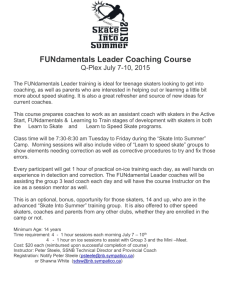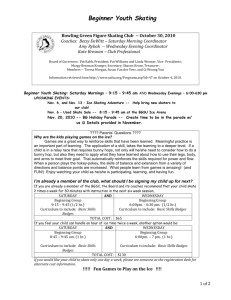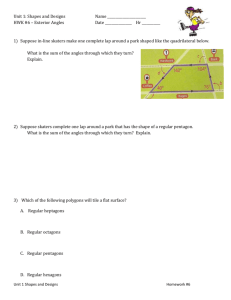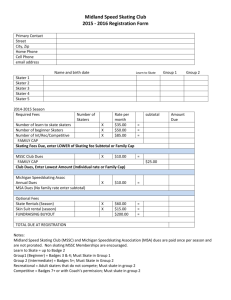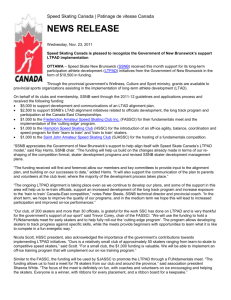Synchronized Skating Primer
advertisement
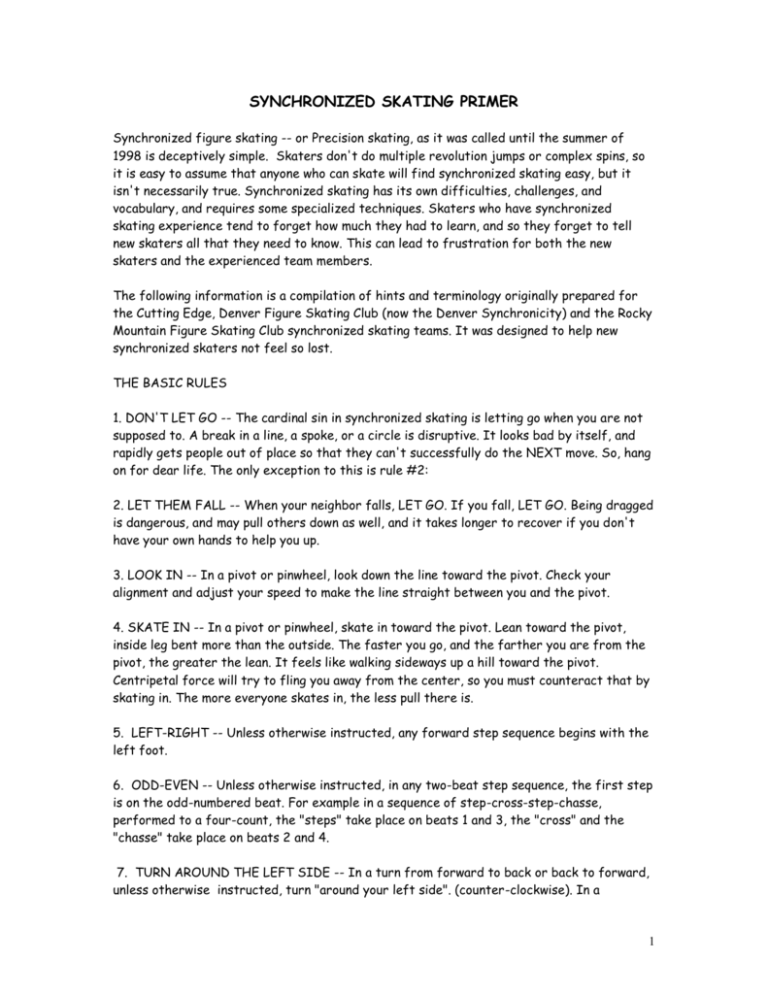
SYNCHRONIZED SKATING PRIMER Synchronized figure skating -- or Precision skating, as it was called until the summer of 1998 is deceptively simple. Skaters don't do multiple revolution jumps or complex spins, so it is easy to assume that anyone who can skate will find synchronized skating easy, but it isn't necessarily true. Synchronized skating has its own difficulties, challenges, and vocabulary, and requires some specialized techniques. Skaters who have synchronized skating experience tend to forget how much they had to learn, and so they forget to tell new skaters all that they need to know. This can lead to frustration for both the new skaters and the experienced team members. The following information is a compilation of hints and terminology originally prepared for the Cutting Edge, Denver Figure Skating Club (now the Denver Synchronicity) and the Rocky Mountain Figure Skating Club synchronized skating teams. It was designed to help new synchronized skaters not feel so lost. THE BASIC RULES 1. DON'T LET GO -- The cardinal sin in synchronized skating is letting go when you are not supposed to. A break in a line, a spoke, or a circle is disruptive. It looks bad by itself, and rapidly gets people out of place so that they can't successfully do the NEXT move. So, hang on for dear life. The only exception to this is rule #2: 2. LET THEM FALL -- When your neighbor falls, LET GO. If you fall, LET GO. Being dragged is dangerous, and may pull others down as well, and it takes longer to recover if you don't have your own hands to help you up. 3. LOOK IN -- In a pivot or pinwheel, look down the line toward the pivot. Check your alignment and adjust your speed to make the line straight between you and the pivot. 4. SKATE IN -- In a pivot or pinwheel, skate in toward the pivot. Lean toward the pivot, inside leg bent more than the outside. The faster you go, and the farther you are from the pivot, the greater the lean. It feels like walking sideways up a hill toward the pivot. Centripetal force will try to fling you away from the center, so you must counteract that by skating in. The more everyone skates in, the less pull there is. 5. LEFT-RIGHT -- Unless otherwise instructed, any forward step sequence begins with the left foot. 6. ODD-EVEN -- Unless otherwise instructed, in any two-beat step sequence, the first step is on the odd-numbered beat. For example in a sequence of step-cross-step-chasse, performed to a four-count, the "steps" take place on beats 1 and 3, the "cross" and the "chasse" take place on beats 2 and 4. 7. TURN AROUND THE LEFT SIDE -- In a turn from forward to back or back to forward, unless otherwise instructed, turn "around your left side". (counter-clockwise). In a 1 clockwise maneuver it may be necessary to turn around the right side in order to maintain momentum, but ask first, because everyone has to turn in the same direction. 8. ARMS STRAIGHT -- Elbows locked. Limp arms and loose elbows give no support to your neighbors, and may pull them off balance. Limp arms allow lines and circles to buckle. 9. DIFFERENTIAL SPEED -- In order for pinwheels to work, skaters at and near the middle skate very slowly. Sometimes they are hardly moving at all. With each position outward from the center, skaters go a little faster. Skaters at the end go the fastest of all. It's important that the center people skate slowly enough to let the skaters on the ends keep up. 10. LEARN YOUR NEIGHBORS' PARTS -- In a performance or competition you will not be able to refresh yourself on what your role will be if your neighbor falls or drops out of the formation. You must know what to do, who to hold onto, where to pass through, etc. if your neighbor is suddenly not there. 11. DON'T STOP -- If someone falls or drops out of a routine, even during practice, don't stop. You will not have the opportunity to stop during competition, so practice coping with accidents even in practice. Keep the routine going until the coach tells you to stop. 12. GRAB IN FRONT -- When you are joining with someone in front and someone behind, you are responsible for looking to the person in front and grabbing their hand (or whatever). You are responsible for putting your hand out in back for someone to grab. HAVE FAITH the person behind you will grab without your watching. 13. CHECK YOUR ALIGNMENT -- constantly. Adjust your speed to keep lines straight, circles round, etc. 14. SHOULDERS -- No matter what direction your hips and legs are skating, your shoulders must be “on the line” along the direction of travel. This isn't always comfortable, but if your shoulders are not along the line of travel, you pull your neighbors out of the path they must take. This is true in straight lines, curved lines, and circles. Roll your shoulders back/open and down to help you maintain the correct formation. 15. FLOW -- A routine should flow from one formation to another, with no stops or pauses while skaters wait for the music to begin the next maneuver. It's important to get to formations at exactly the right moment so that you can be stable enough to begin the next move, but so you will not look as if you had to wait. 16.HEADS / HANDS / SMILE -- Each step consists of the feet, location, head, and hands. As soon as you know the step, always practice it WITH the correct head and hand position, and with a smile (unless the move or music requires some other expression) 2 17. LOOK UP -- Hold your head up, and look at the top of the stands. If you look down, or straight out at eye level, the audience and judges will see only the top of your head. Practice this every time. 18. SMILE -- Smile throughout the program unless otherwise instructed. A frown or a serious look gives the impression that you are uncertain of the routine. It is hard to remember to smile, especially with the stress of competition, so remember to smile during practice, to make it a habit. 19. PERFORM -- A precision routine is a performance, not an exam. Look as if you are delighted to be there, and can hardly wait to show what a great routine you have. Perform as if you had just jumped out of a cake. Concentrating on the fun and on projecting the performance will make the steps easier and faster, and will help get the audience and judges into the routine. 20. EXAGGERATE -- Make every move big. The audience and judges are a long way away, and whatever you do looks smaller from a distance. 21. PRACTICE -- Every move needs to be automatic. The only way to make this happen is to practice it. Practice on your own, on ice, in your living room, and in your dreams. 22. MATCH -- The second most serious sin in synchronized skating is not matching the rest of the team in your steps. You must all be the same in timing, in style, and in degree. Kicks and chasses should be the same height, extensions should match, spirals should be equally high, head turns should be equally sharp, etc. It is not a virtue to show how high you can kick if no one else can match it. 23. KNOW THE MUSIC -- The third most serious sin of synchronized skating is not skating to the music. The only way to make sure that you skate to the music, and on time with it is to know the music intimately. Get especially familiar with changes between pieces of music, pauses, and changes of tempo, so that your body just KNOWS when the change is coming and how long it takes, and so that if you miss a step or fall and have to get back to the routine, you know just what to do as soon as you have gotten over the problem. 24. KNOW THE COUNTS -- You can't rely on watching other people to let you know when to do things, or what to do. You must know for yourself how many of what is done and in what order. If you wait for a hint from other skaters, you will do the steps late. 25. DON'T RUSH -- In the excitement of competition, the tendency is to rush. Keep track of the music, and don't get ahead of it. Finish each move before starting the next. Rushing and anticipation shows up especially in kicklines, and in transitions where a team gets to a new formation so early that they have to wait for the music before beginning the next formation. If you are getting someplace too quickly, adjust your speed. 26. WHEN A CIRCLE BREAKS -- the ends drift out, and the skaters at the break cannot rejoin by themselves. They need help from the whole circle. All skaters near the break 3 (within about 4 or 5 from the end) need to skate IN, trying to make the circle smaller. Pull in with the inside foot, and push in with the outside foot. The skater on the trailing end of the break needs to aim NOT toward the person they are trying to join, but farther in, several people in from the other end of the break. 27. WHEN THE LINE BREAKS -- skate in toward the break. Skaters on both sides of the break need to help. If the line that breaks is in a pinwheel, skaters outside the break need to skate in as hard as they can, and skaters on the inside need to take care not to let the pinwheel speed up now that fewer skaters are attached. 28. WHEN YOU FALL -- Let go. Get out of the way. Pull your hands in. Rejoin as quickly and with as little disruption as possible. BUT ...... 29. WHEN YOU FALL IN COMPETITION -- Let go. Get out of the way. If you cannot rejoin immediately, skate to the side of the rink near the judges and crouch down so you cannot be seen. Wait until the formation comes close, and rejoin as unobtrusively as possible. If you cannot rejoin before the end of the routine, skate to your place in the formation after the closing pose, and skate off with the team. 30. DON’T CHASE -- When you fall in competition, try to get back into the formation as unobtrusively as possible. If you are the lone skater chasing the formation, it continues to call attention to the mistake. So, try to judge when and were you can get in, skate in the same direction as the formation, doing the same steps and then just blend in. 31. KEEP DOING THE STEPS -- When the formation breaks, or if you haven’t yet made it to the formation, keep doing the correct steps. It will call less attention to the fact that you aren’t where you should be. HOLDS There are many different ways to hold on to other skaters, and a good routine will have a variety of holds. Holds are constantly evolving, but these are the basic ones SHOULDER -- Left arm in front, right arm in back. Arms straight. The one-in-front/onein-back hold gives stability. If you have both arms in front you will be pushed forward off the line. If both are in back, you will drop off the back. (Note that on some teams, the left arm is in back and the right is in front. Do whatever is the practice for the team with which you are skating) HANDS -- Palms in. (Place your hands at your sides, palms on your thighs, then extend forward or back as Appropriate. Right thumb up, left thumb down. You are responsible for grabbing the hand in front. On the hand with the thumb up, wrap your thumb and forefinger around your neighbor's wrist, and have her thumb (which will be pointing downward) between your little finger and the next finger. Having the thumb between two fingers is what gives this hold its 4 stability. One hold will feel more secure than the other, but remember that to the other person in back of you, her hold on YOUR hand feels secure. WRISTS -- Wrists facing. Wrap your whole hand around your neighbor's wrist, extend your forefinger up the inside of her arm. Wrist holds can be painful on a curve, when half the wrists are forced to bend backward ELBOWS, OPEN ELBOW -- Grab above the elbow, not on it. OPEN ARM -- Grab below the elbow. OPEN – No hold. Hands down to side, unless otherwise instructed. Maintain spacing without holding on. CHOO-CHOO -- There are several types. The most common is with both hands on hips/waist of skater in front of you. Sometimes one hand will be on the waist, and the other on the shoulder. Sometimes both hands will be resting on the shoulders of the skater in front. BASKETWEAVE -- there are several types, but each involves holding the hand of the skater just beyond your neighbor on either side. The basketweave puts skaters very close to each other, and can be extremely stable. The important thing, once you have gotten connected, is to keep your elbows locked to give support to the line: FRONT BASKETWEAVE -- Stand in a line, side by side, hip to hip. Extend your right hand to the side, reaching across in front of your neighbor, and take the hand of the person just beyond her. The neighbor to your left will extend her right arm across your front to hold the hand of the person to your right. Now put your left arm over the hand that is stretched across you from the left, and grab the hand of the person just beyond. The person to your right will put her left arm over your right, to take the hand of the person to your left. You have one hand over and one under, one palm facing out and one facing in. The skater on the end of the line takes the "last free hand" with her outside hand. BACK BASKETWEAVE -- as above, but hands are in back, one over and one under, one palm out, and one in. MOCK BASKETWEAVE -- Two lines of skaters in a hand-to-hand hold merge into one, with one line ducking under the arms of the other line, and coming up in the spaces, still holding on. If the line that ducks comes from the back, the basketweave will be in back. If the line backs in from the front, the basketweave will be in front. Another type of mock basketweave has one line ducking under into the spaces of another line, letting go of hands and reconnecting on the other side, while the line that didn't duck keeps its original hold. TEAPOT, TEACUP -- Crook one elbow and place that hand on your hip. The other hand holds onto the upper arm of the neighbor who has crooked HER elbow. You have to HOLD the crooked arm in place and not let it get pulled out, or else the neighbor holding it will slide away. GOALPOST -- Arms out at shoulder height, bent at elbows, lower arms pointing upward, palms in to form a "goal". The upper arms are "wrapped" so that your arm and palm are pressing inward toward you AGAINST your neighbor's arm and palm which are pressing inward toward her. HALF GOALPOST -- Shoulder hold, but one arm is bent upward at the elbow. Each skater has the same arm up, e.g. all skaters have left arm holding right shoulder of their neighbor, and right arm bent upward. In this hold, the only thing keeping the line together is the single arm (in this case the left) holding the neighbor's shoulder. 5 LATTICE -- In a block or a parallel pinwheel, one arm connects to the skater beside you, and the other to the skater in front of you. OPPENHEIMER – this usually takes four skaters, hands joined, overlapping, to form the hold seen in Oppenheimer insurance ads – each skater has hold of one wrist, and is held by another. This hold is often used in the center of pinwheels. If it is done with three skaters at the center of a 3-spoke wheel, it can be painful if one of the spokes is out of place. CROOKED V – both arms overhead, one at a sharper angle than the other. Your neighbor grabs your higher arm. This is not a very stable hold, and pulls apart easily. FORMATIONS Formations are constantly evolving, and many have a variety of names. All formations are some variation of the five basic types: wheel, line, circle, block, and intersecting move WHEEL, STAR, PINWHEEL -- Spokes should be evenly spaced, and each spoke extends straight out from the center unless otherwise instructed. A pinwheel can have as few as one line rotating around a spot in the center of the line, or it can be composed of as many spokes as can fit around a common center. Pinwheels with more than six spokes are unusual. HOLLOW WHEEL, OPEN WHEEL -- A Wheel in which the spokes are not joined at the center. PIVOT OR ONE PIN -- A line that pivots around one end. The line should extend straight out from the pivot point. S-WHEEL -- A pinwheel composed of a single line in which the two ends are curved strongly opposite each other to form an S. The ends of the S should not extend beyond the pivot. INFINITY, EIGHT -- An S-Wheel in which the ends are joined across the pivot to form an infinity sign, or a figure 8. WRAPPED WHEEL -- A pinwheel with three or more spokes in which the spokes are curved all in the same direction to wrap around the center. HURRICANE OR TRAVELLING STAR OR TRAVELING PINWHEEL -- A pinwheel in which the center of rotation (the pivot point) changes position on the rink. PARALLEL PINWHEEL -- A wheel in which two or more parallel lines rotate as if they were one. The hardest thing in a parallel wheel is keeping the centers of the lines aligned with each other. OREO -- A three-line parallel pinwheel, in which the center line is doing something different from the other two. For example, the middle line may be in a spiral, with skaters holding the waists of the line in front, and having their feet held by the skaters in the line behind. ADD-ON PINWHEEL -- A wheel in which skaters join onto the ends as the pinwheel rotates, adding to the length of the line. This is considered more a show move than a competition move. EGG BEATER -- Two or more pinwheels rotating close to each other in opposite directions and slightly out of phase, so that the spokes overlap. 6 JUMP ROPE -- An eggbeater in which one or more lines or circles of skaters are not in the pinwheels, and skate through the middle of the eggbeater as it rotates, rather like double-Dutch jump rope. GEAR -- An egg beater in which one pinwheel remains in place, while a smaller pinwheel travels around the outside, meshing with the spokes of the larger wheel as it goes. REVOLVING DOOR -- Pivots and/or pinwheels that overlap slightly so that skaters must release and rejoin in order for the lines to pass by each other. EGG, BALL, SNOWBALL -- A small circle that travels in or through a larger formation BLOCK -- Any arrangement of multiple lines in a block. The alignment of lines and rows needs to be maintained throughout a block maneuver. Blocks are often nicknamed by what footwork is contained in them, or by the music they are skated to in a particular program (e.g. the waltz block, the lunge block) PYRAMID BLOCK -- A block in which lines are graduated in length and offset so that a solid triangular shape is formed (e.g. three lines 3, 5, and 7 skaters long). Alignment of lines is extremely important so that the pyramid shape is maintained throughout the maneuver. ROTATING BLOCK -- A block in which the entire formation rotates around a common center, maintaining the block form throughout. (like a parallel pinwheel with three or more short lines) LINE, KICKLINE -- A straight line, often of the entire team. HINGE -- A line folds in the middle and the sides approach each other as in the closing of a hinge. Skaters can either stop at the point the lines meet, and form two parallel lines, OR, one or both of the lines can let go, and skaters pass through to let the hinge open up again. PASS-THROUGH, INTERSECTION -- Any move in which two lines or sets of lines pass through each other usually (but not always) by having one or both of the lines or sets of lines let go and rejoin following the pass. CROSS OR PASS -- Two lines, originally end-to-end, skim past each other face to face or back to back, trading places and usually forming a single line after the pass/cross. The skaters that were on the outside at the beginning are in the middle after the cross. If the two lines are opposite spokes of a pinwheel, it is usually called a cross, if the lines are not part of a pinwheel, it is usually called a pass. V, ARROW, CHEVRON -- A line or set of parallel lines shaped like a V or a V within a V. PEEL-AWAY, SWOOP, SWOOSH, TANGENT, ZIPPER -- Two or more lines come very close to each other and then curve away, "glancing off" each other. Lines are usually face to face, skaters have feet held in line with each other, both travelling on the same tracing, one foot in front of the other, one on an inside edge, one on an outside edge. CIRCLE -- The fewer the skaters, the greater the torque and the more difficult it is to perform complex footwork. THREAD THE NEEDLE -- A move in which one or more lines pass through perpendicular to another formation by passing between the skaters of the other formation. CLOCK, LOLLIPOP -- A line pivots around one end. A circle forms around the pivot end, with the center of the circle being the pivot point of the line. Both the line and the circle rotate, sometimes in the same direction (but at different speeds), sometimes in opposite directions. The skaters in the circle duck under the line as it passes over them. If the line is short in relation to the size of the circle, it's a clock. If the line is long, it's a lollipop. 7 SNAIL -- A line that curves in on itself. The formation is circular, but the ends are not attached, and the inner end is "wrapped" by the remainder of the line. TRAVELING -- Any rotating formation can be made to travel, that is to change the position of its center on the rink. SATURN -- A pinwheel consisting of a single line pivoting at its center, with a circle formed around the center portion of the pinwheel. The circle can either be attached to the line, or it can move independent of the line, passing through at 2 points. INTERSECTING MOVE -- This is official term for any move in which skaters or groups of skaters "pass through" other skaters or groups of skaters. It can apply to lines, blocks, circles, etc. 8
